
Saldanha Bay West Coast National Park
You can enjoy endless miles of beaches plus wetlands and over 200 species of birds at West Coast National Park by hiking or driving the 20+ miles of paved road. I always deny being a birder and even though I don’t chase them or look for any specific species I do enjoy watching.
I stayed with a delightful woman from Germany I met at Warmwaterberg Spa. She has a South African summer home in Langebaan. This was a convenience to also visit the West Coast Fossil Park.
My Wild Card got me into the park for free. At the entrance gate the person was surprised when I asked for a park map/brochure because so many locals visit and already have it. I drove in only part way the first day then returned a second day to see the rest.

Aerial view of Langebaan Lagoon by Scott Ramsay
West Coast National Park
West Coast National Park was established in 1985 and comprises 79,000 acres (32,000 hectares) surrounding the clear waters of the Langebaan Lagoon. The lagoon itself is divided into 3 recreational zones with different activities and facilities in each; Zone A: multi-functional section for most water sports at the mouth of the bay; Zone B: reserved for sailboats and board sailing, no power boats or angling; and Zone C: wilderness area, which is closed to the public.
The key conservation areas of the park include the lagoon and the offshore islands in Saldanha Bay. The saltmarshes of Langebaan are unique in that no river feeds into the lagoon. The five islands of Saldanha Bay to the north of the Lagoon provide a home for nearly a quarter of a million sea birds, many of which are endemic to the nearshore regions of South Africa and Namibia.
Activities
Besides beaches and birding West Coast National Park offers many other activities which I unfortunately didn’t have time for. Oh boy, an excuse to go back.
Birding
I visited two of the four bird hides and saw an incredible number of species. Bonus that identification photos are hung in the hides so I could figure out what I was looking at.
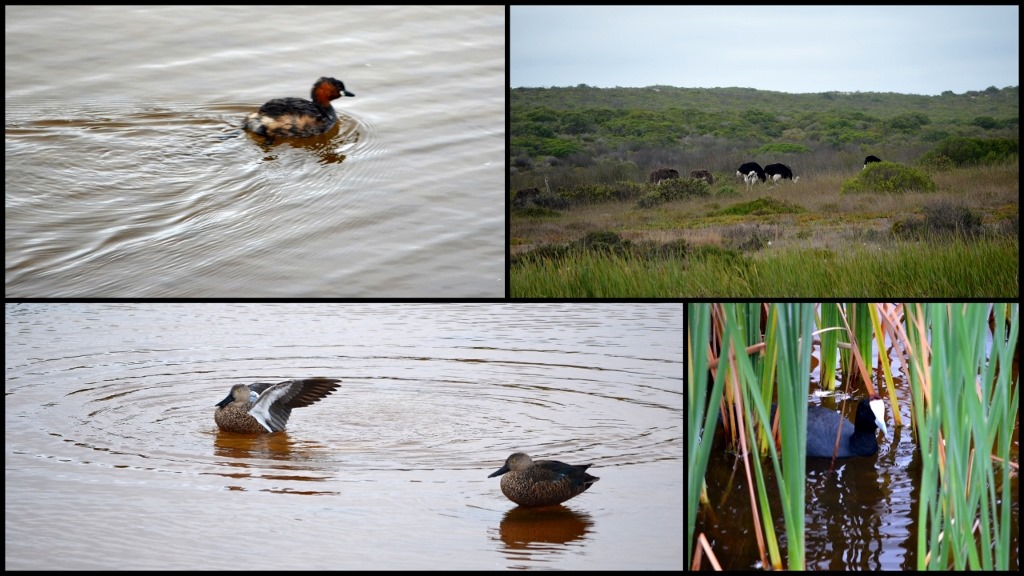
Whitebacked duck, ostriches, red-knobbed coot and Cape shovelers (clockwise)
Birding is a serious business to many. It is important to be respectful and quiet when approaching, visiting and leaving a bird hide or it defeats the purpose of hiding. Other birders in the hide had field guides and Big lenses mounted on tripods. I’m an amateur and birds are flighty and challenging to photography. (I need lessons from my birder friends Chris and Kathie.)
Wildlife
What I saw the most of was Angulate turtles. They have right away and you have to really watch out for them because they cross the roads regularly, and slowly. Eland, red hartebeest, Cape grysbok, caracal and rock hyrax are some of the terrestrial species to search for. And watch for whales in August and September from the Tsaarsbank section of the park.
Flower season
West Coast National Park boasts a popular and colorful flower season annually between August and September depending on the amount of rainfall in the preceding winter months. I missed this but there were still a few things in bloom.
Geelbek Information Center
This Cape Dutch building is a National Monument and has been renovated three times since it was first built in 1744. The well laid out information center displays information about the flora and fauna of the park. Plus a replica of Eve’s footprints, discovered in 1995 at Kraalbaai, are unmistakable human footfalls in rock (formerly sea sand) and are said to have belonged to a young woman who lived 117 000 years ago. The original prints are housed at the Iziko Museums’ South African National Museum in Cape Town. Trails to two birdhides start at the visitor center.
There is also an award winning restaurant that serves traditional food and only regional wines with indoor or outside dinning and a bar. Although I didn’t eat there I paused long enough to watch these Weavers playing in the fountain in between begging from the outdoor dinners.
Hiking
Unfortunately my hiking time was limited although I did walk out to the Seeberg View Point which provided a huge view of Langebaan Lagoon. There is a seemingly abandoned yet freshly painted one room building sitting on top of this huge outcrop. I’d be totally ready to live there as a volunteer with the addition of a compost toilet.
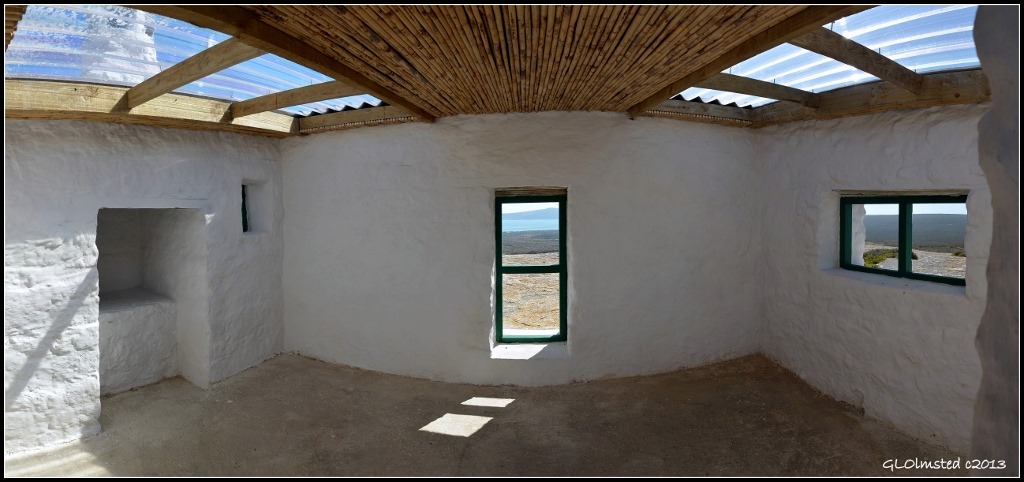
Eve’s Trail is a 2.5 day, fully portered and catered hike through the park, tracing the footsteps of Eve. The trail is an 18.5 mile (30 km) wilderness hike consisting of three legs connected through a series of West Coast-style meals and transfers.
Beginning at the Geelbek Information Centre there is a 5.5 mile (9 km) circular walk to the dunes and back and a 4.3 mile (7 km) circular walk that includes part of the 16 mile beach.
Bakoor Trail from the Langebaan gate to the Seeberg View Point is 2.8 miles (4.6 km) long. Along this route bat eared foxes, Ostriches, Eland and many other animals can be spotted, as well as the beautiful view of the Langebaan lagoon.
The Strandveld Trail is a two-day hike, 8.6 miles (14 km) each day through endangered beach scrub and along the beach beginning and ending at the Geelbek Information Centre.
Only during the August and September flower season the two-day Postberg Trail and one-day Steenbok Trail require pre-booking that opens in June.
Cycling and mountain biking routes
I’d rather walk but there are cycling options on the roads for an 18.6 mile (30 km) ride from the Langebaan gate to Geelbek and back, or a 43 mile (70 km) ride from the Langebaan gate to Kraalbaai and back.
Plus you can mountain bike the 8 mile (13 km) Green Trail which starts at the Langebaan gate and traverses up to the Seeberg Bird Hide before heading back to the gate. And also the 10.5 mile (17 km) Red Trail which uses a similar route to the Green route, but heads up instead to the Seeberg Lookout and thereafter to Mooimaak before heading back to the Langebaan gate.
Picnic and braai (BBQ)
Nice facilities are offered at both Kraalbaai’s beach on the lagoon or Tsaarsbank section along the Atlantic.
Kite-board
Just outside the park proper I watched people kite-boarding in the Langebaan Lagoon. Sure looked like fun but don’t think my arthritic shoulders could handle this.
People and Conservation
National Parks are so much more than awesome wildlife and scenery. The preservation of biodiversity includes people.
South African National Parks (SANParks) is mandated “to oversee the conservation of South Africa’s biodiversity, landscapes and associated heritage assets through a system of national parks.” This also includes a mission to build constituencies among people and conservation through effective relations in communities near national parks, youth outreach and environmental education.
I met two Honorary Rangers waiting for a field trip of kids that were hiking towards them to learn about the birds seen at Seeberg hide plus take advantage of an interpretive moment and show them the scattering of red-hartebeest dung/scat/poop and the characteristic scratch mark next to it.
Accommodations
Other than overnight hiking by permit there are no other camping options in the park and limited near Langebaan where it might be uncomfortable camped on a windy beach. However, West Coast National Park offers a few accommodation facilities within the park. The Abrahamskraal Cottage near a bird hide and Jo-Annes beach Cottage within walking distance to the west side of the lagoon can be reserved through SANParks.
I saw several boats anchored near the Kraalbaai picnic area and later learned two privately owned and permanently moored houseboats are available for overnight reservations. That would be a unique experience.
Nearby in Langebaan many overnight accommodations are available ranging from beach houses, B&B and hotels.
My favorite part of West Coast National Park was truly the west coast, right on the Atlantic Ocean. I hung out watching the waves, exploring tide pools, walking the beach, and, yes, watching birds.
Getting There
Only 1.5 hours north of Cape Town on the R27, West Coast National Park provides plenty of beaches and birds plus a whole lot more.
This post is linked to a Blog Hop about the “Top Stories of 2013” by our Baby Boomer Travel Writers Facebook group and hosted by Travel writer Liz. Hop on over for some great travel ideas.

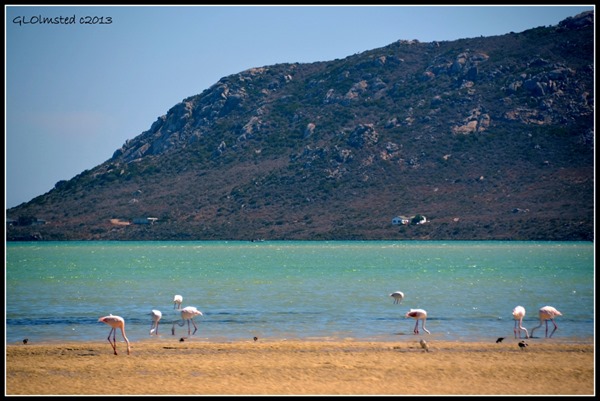
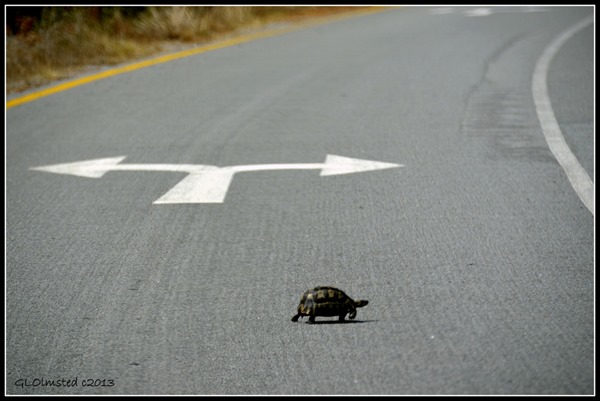
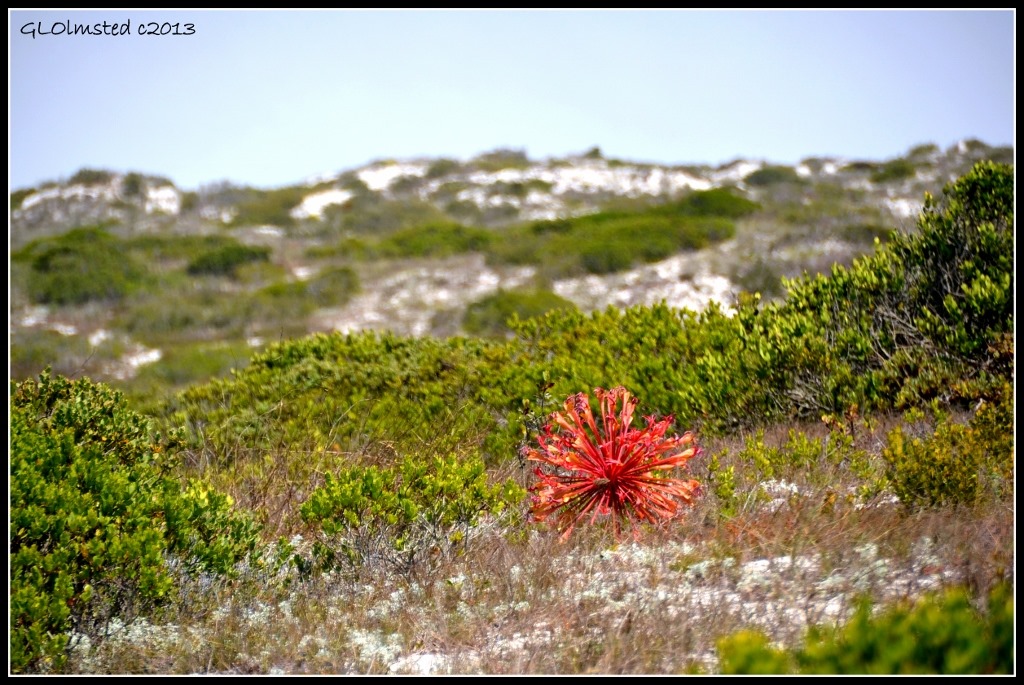

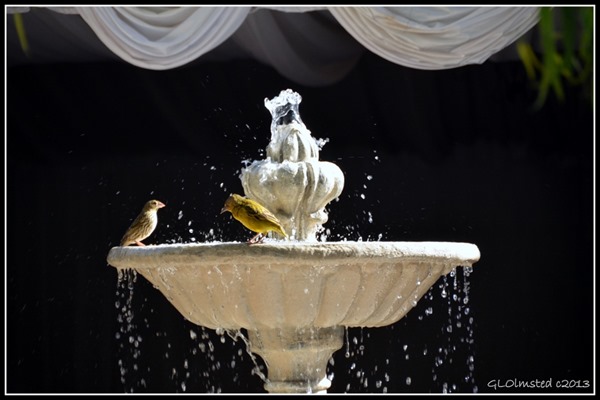
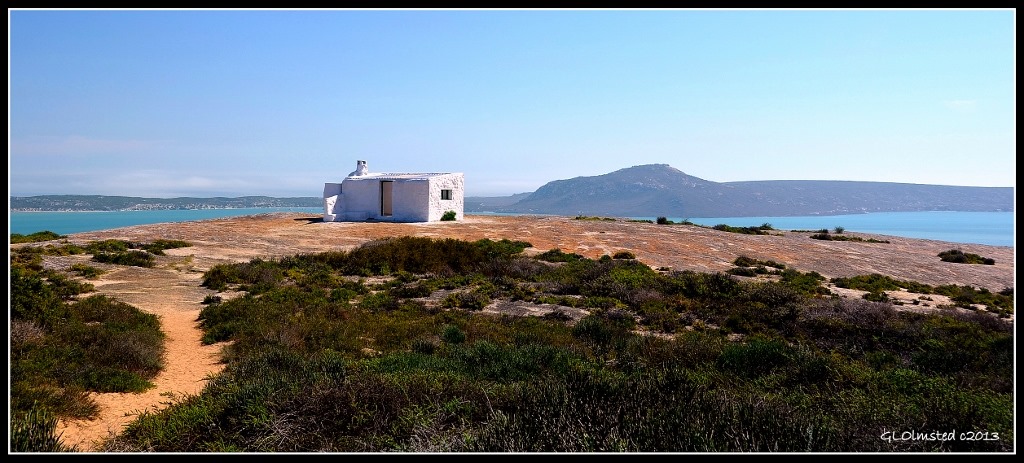

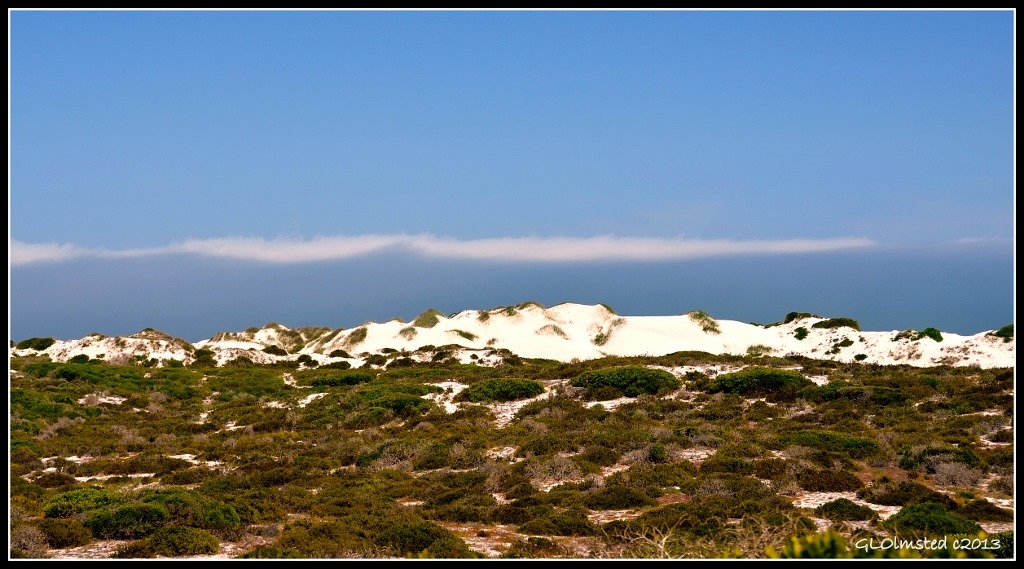


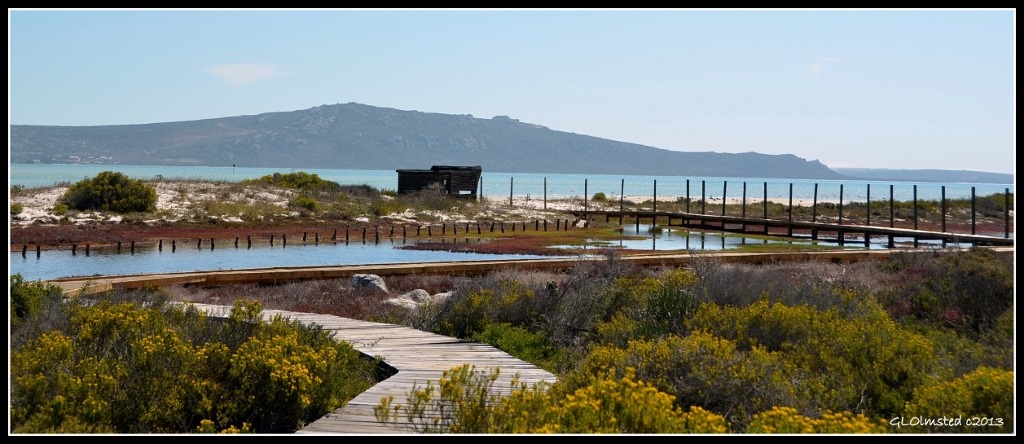
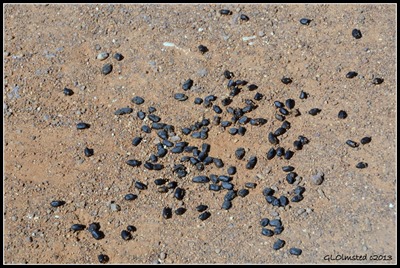
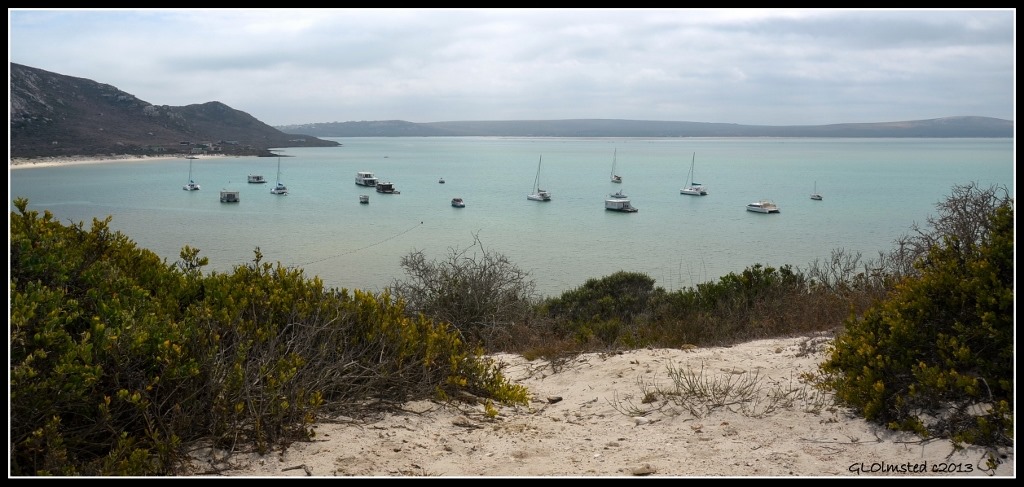


South Africa’s West Coast area is so different from the south coast and east coast. Only difference is that the water is ice cold. But still very beautiful
I never even put my toes in that cold Atlantic.
The amount of information you gather at every place you visit is just amazing! Well done!
To me a big part of travel is learning.
These are just some of the most amazing pictures. The opening two nearly knocked my sox off and the turtle on the road. Love that they have the right of way. A great law if I ever heard of one. I also like “bird hide” rather than “bird blind”. Makes much more sense I think. I’ll be your roommate in the one room building. GREAT picture!! 117000 years old – wow. Eve’s foot prints – wow. West Coast National Park – wow. This whole post – WOW!!
Much like you, I am rarely disappointed in National Parks. And this one, like most deserves more exploration. I really want to spend more time at the places I visit this time. A day, even plus half, is just never enough.
This is one place I have not been and hope I get to see it soon. A great and infomative post Gaelyn. Thanks.
It’s on the list for this trip.
What a stark landscape. I love the turtle and the arrows.
Those turtles were everywhere. Really had to watch out. Stark yet beautiful.
Thanks for this piece. Most visitors to Africa focus on the big animals and don’t realize how rich the birds and other wildlife are~
South Africa is so much more than the Big 5. The cultural and bio-diversity are inspiring.